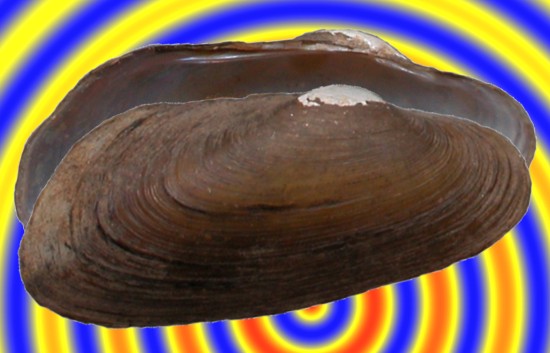| Page last updated
24 December 2007 |
Mussel of the Month
The October 2005 Mussel of the Month is Lortiella froggatti. Lortiella is a small genus confined to the northwestern part of Australia.

FMNH 115329. Lennard River, northwest Australia. W.W. Froggatt!
(paratype of L. froggatti)
At present, the genus Lortiella contains only three species, although one of those was just recently described. Anatomically, it is similar to the genus Velesunio, but Lortiella is more elongate in outline.
Based upon recent phylogenetic work (Graf & Cummings, accepted), Lortiella forms a clade with Velesunio (and some other genera) known as the Velesunioninae. That subfamily is a remnant of the basal lineage of the Hyriidae. Like the platypus, velesunionines are "living fossils" found only in Australasia.
Classification:
Phylum Mollusca
Class Bivalvia
Subclass Palaeoheterodonta
Order Unionoida
Superfamily ETHERIOIDEA Deshayes, 1830
Family HYRIIDAE Swainson, 1840.
Subfamily VELESUNIONINAE Iredale, 1934
Genus Lortiella Iredale, 1934
Species Lortiella froggatti Iredale, 1934
For more information about Lortiella and the Velesunioninae, check out the following:
- McMichael, D.F. & I.D. Hiscock. 1958. A monograph of the freshwater mussels (Mollusca: Pelecypoda) of the Australian region. Australian Journal of Marine and Freshwater Research 9(3): 372-508 + 19 plates.
- Graf, D.L. & D. Ó Foighil. 2000. Molecular phylogenetic analysis of 28S rDNA supports a Gondwanan origin for Australasian Hyriidae (Mollusca: Bivalvia/ Unionoida). Vie Milieu 50: 245-254.
- Ponder, W.F. & M. Bayer. 2004. A new species of Lortiella (Mollusca: Bivalvia: Unionoidea: Hyriidae) from northern Australia. Molluscan Research 24: 89-102.
- Graf, D.L. & K.S. Cummings. (Accepted). Palaeoheterodont Diversity (Trigonioida + Unionoida): what we know and what we wish we knew about freshwater mussel evolution. Zoological Journal of the Linnean Society.
|